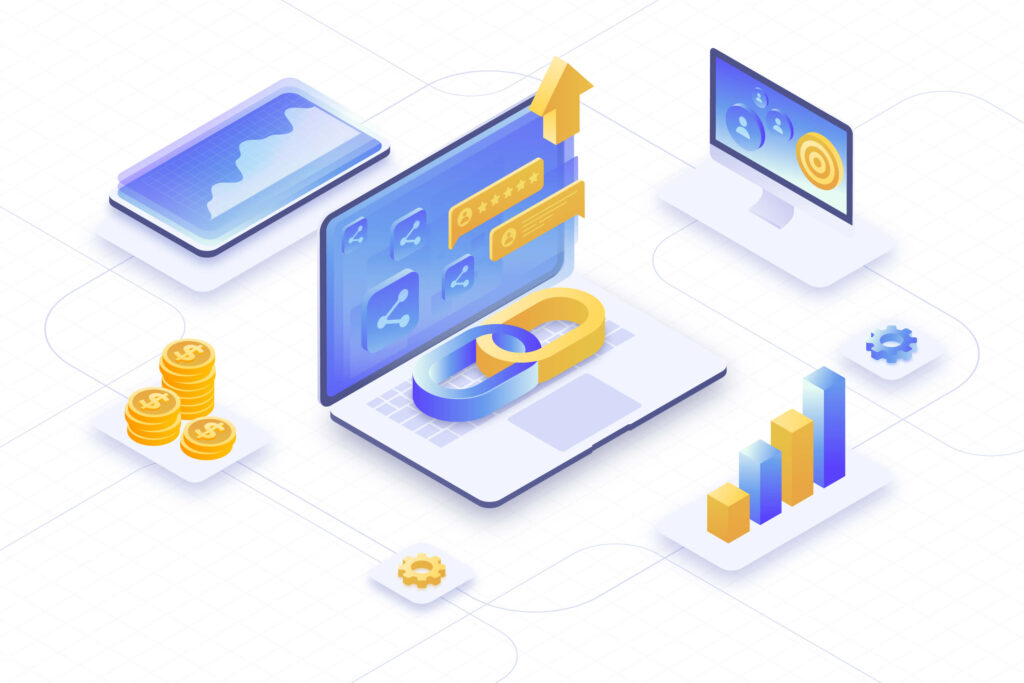2D vs 3D Animation: What’s The Difference?

When it comes to 2D vs 3D animation, what’s the real difference? And which one is right for your financial enterprise?
Let’s explore the ins and outs of both and allow you to make informed decisions that convey your message most effectively.
2D vs 3D Animation: The Fundamentals

2D Animation Overview
This traditional form of animation exists in a two-dimensional space. Think of classic cartoons or infographics that lay flat.
For the financial services industry, 2D animation can quickly depict graphs, other data centric representations as well as explain complicated products and services.
As the name suggests, 2D animation deals with two dimensions, width and height. It is flat, with no depth to the characters or objects, although this can be simulated with special effects within the software or drawing techniques.
When we’re referring to 2D animation in this article, we’re mainly talking about 2D motion design, which we’ll explain next.
The Difference Between 2D Motion Design & Traditional 2D Animation
While both 2D motion design and traditional 2D animation are grounded in two dimensional space, there are some key differences .
2D motion design is the streamlined, contemporary face of animation. It uses objects, simpler characters, symbols, and text and presents information with a modern and sleek look. It’s graphic design mixed with animation.
This style, with its versatility and adaptability, truly comes into its own in areas like data visualisation and explainer videos, where clarity and brevity are important.
On the other hand, traditional 2D animation is the canvas of boundless imagination, reminiscent of classic animated films like The Lion King and Snow White. Their richness in detail and depth allows for more expansive creative exploration.
While this means almost limitless creative possibilities, it also means more investment of time and resources.
This style’s beauty lies in its ability to bring stories to life in a detailed and expressive manner, making it perfect for narratives that require emotional depth and artistic nuance.
In essence, while 2D motion design is more about efficient and stylish communication, traditional 2D animation prioritises artistic depth. In most cases 2D motion design will be just what you need.
3D Animation Overview
3D animation creates a sense of depth and realism. It’s akin to sculpting a statue versus drawing on paper.
It employs three dimensions: width, height, and depth, allowing for dynamic rotations and movements within a three dimensional space.
In the context of financial services, imagine a dynamic 3D pie chart in motion or a lifelike representation of a bank’s operations or an intricate investment strategy unfolding in a 3D world.
2D vs 3D Animation: The Pros and Cons of Each

With any choice, there are inherent advantages and disadvantages. To ensure your financial institution’s visuals align with your goals, budget and audience, let’s break down the advantages and disadvantages of each.
2D Animation Advantages
Simpler Production
Its linear and straightforward approach means that there’s less complexity involved. Rather than juggling multiple layers and depths as in 3D, 2D offers a more direct path from concept to completion, making the production process streamlined and efficient.
Cost Effective
Financial considerations are important in any business decision, and animation is no exception. 2D animation is normally cheaper to produce than 3D animation.
It often requires fewer resources than its 3D counterpart. For shorter projects or explainer videos, where high detail and realism aren’t primary concerns, 2D is the best option without compromising on the quality of the work.
Stylisation Flexibility
One of the standout strengths of 2D animation is its ability to adapt to varied visual styles.
Whether your financial brand wishes to project a light-hearted, playful demeanor through cartoonish illustrations or aims for a more mature, sophisticated look with refined designs, 2D has a solution.
This flexibility allows financial services companies to cater their messaging to a diverse audience, from younger clients to seasoned investors.
More Straightforward Revisions
2D animation is technically more simple than 3D, meaning it’s particularly well suited for swift and efficient edits. This is good for projects that are up against tight deadlines.
Beyond just the ease of revisions, 2D animation excels in its capacity for templated work.
There are many ways financial institutions can implement animation, ranging from explainer videos on asset management to periodic market trend updates. All this will require a consistent visual theme.
2D animation excels in providing a stable visual theme while allowing for straightforward changes.
2D Animation Disadvantages
Dimensional Restrictions
By design, 2D animation lacks the depth and dimensionality inherent in 3D animation.
In the context of the financial world, where certain products or platforms might benefit from a more immersive presentation, this flatness can be a drawback.
For example, when introducing a new financial software, a 3D representation could better convey its multifaceted features and depth, giving the audience a more tangible understanding of the product’s capabilities.
Movement Constraints
2D animation shines when depicting straightforward, linear movements. Its strength lies in portraying simple actions directly and elegantly.
However, when the narrative demands more detailed animations such as a rotating currency coin, 2D can sometimes struggle to deliver the desired level of realism and engagement.
While skilled animators can replicate dynamic movements in 2D to a certain degree, the time taken to achieve it is sometimes just not worth it. 3D animation, with its capability for comprehensive rotations and movements will be more suitable.
3D Animation Advantages
Real World Realism
3D animation can bring a dimension of depth that mirrors real world experiences.
Whether you’re aiming to provide a virtual walk through of a soon to be launched bank branch or giving a detailed overview of a new financial product, 3D animation can bring these visions to life in a realistic way.
This added layer of depth can create a more engaging and immersive experience for your audience.
Adaptable 3D Models
One of the standout benefits of 3D animation is the adaptability of its models. Once a model is created, it’s not set in stone.
It can be positioned, repositioned, rotated, and modified to align with varying scenes without the need to start from scratch.
This means a single 3D model can be reused across various marketing or educational materials, ensuring brand consistency and reducing production time.
Complex and Eye Catching Animations
3D animation excels at bringing ideas to life in a way that is both visually appealing and highly stimulating.
3D animation, with its advanced depth and dimension provides a vast canvas to weave in details that would be challenging to capture in a 2D space.
The realism that 3D offers can make visual sequences pop, capturing your audience’s attention and making the content very memorable.
Think about the vastness of the financial sector, from the flow of digital transactions to the intricate workings of stock market exchanges.
Using 3D, you can recreate these processes in a visually stunning manner, allowing viewers to visualise things like, how digital currencies move within blockchain networks or how stocks rise and fall.
This depth and flair can elevate your viewer’s understanding, enjoyment and engagement, ensuring your message is truly absorbed.
3D Animation Disadvantages
Typically More Expensive
While you often get what you pay for in terms of quality, uniqueness, and eye catching visuals, 3D animation can be pricier than 2D animation.
However, this isn’t always a drawback if your budget allows for it. 3D is worth the investment if you can afford it.
Premium visuals usually come with a higher price tag, and in the realm of animation, detailed 3D projects will usually cost more.
Extended Production Time
Every masterpiece takes time, and 3D animation epitomises this. While specifics can vary with each project, the process will at a minimum involve 3D modeling, texturing, lighting, and animation.
The 3D animation process can also involve complicated steps such as, creating and animating characters, creating the character skeletons (a process called rigging), and executing advanced simulation effects, like generating water and particle movements.
This means that while the end product is often visually stunning, you should be prepared for longer production timelines, especially when compared to 2D projects.
Use Cases For 2D & 3D Animation

Now that you grasp the differences, advantages, and disadvantages of both, you’re better equipped to utilise these powerful and versatile tools.
Let’s explore specific scenarios where either 2D or 3D animation shines.
2D Animation Use Cases
Instructional Videos or How-To Videos
If you’re looking to educate your clients and customers about a new banking process or how to navigate an online platform, 2D animations can demonstrate how to do this with step by step visual instructions.
This will alleviate the load on your customer support team who likely deal with the same FAQ inquiries over and over again, and also elevate the overall customer experience.
Animated Explainer Videos
When launching a new financial product, service, or even introducing your brand to the market, 2D animations can vividly showcase its benefits, functionalities, and unique selling points in an engaging way.
3D Animation Use Cases
3D Virtual Tours and Visualisations
When envisioning a new bank branch, 3D animation allows you to take stakeholders on a virtual tour, immersing them in the space before it even exists.
Every corner, every interactive kiosk, and every customer touchpoint can be visualised in meticulous detail.
You can showcase integrations and innovative design layouts, and demonstrate the future of your banking operations, emphasising user experience and operational efficiency.
3D visualisations can serve as a bridge and make abstract ideas tangible and greatly help to drive strategic decision making.
Product Demonstrations
If you’re launching a tangible financial product, like a new credit card design or a POS System, a 3D representation can provide viewers a near-real experience of the product.
When choosing between 2D and 3D animation, your project’s specific needs should guide the decision, not only your personal preferences.
Also keep in mind that there can be some overlap between 2D and 3D animation. For example, you can certainly create a fully 3D animated explainer video, just bear in mind it will like cost more.
Also, a video can incorporate elements from both styles. You might choose to enhance a 3D animation with 2D elements, such as integrating 2D text animations to highlight key points in the video.
Conclusion: 2D vs 3D Animation
In the end, there is no winner. 2D and 3D animation are both great.
Each has its strengths, nuances, and distinct artistic expressions, catering to different visual needs and narratives.
Whether it’s the efficient and reliable 2D animation or the detailed depth of 3D visuals, understanding the core differences and potential applications is essential to using them.
As with any strategic decision, the objective is to convey your message in the most impactful, memorable, and effective manner.
Whether you lean towards 2D’s simplicity or 3D’s immersion, it’s all about finding the perfect balance that resonates with your audience and aligns with your goals.
If you’re ready to bring your financial stories to life with animation, whether 2D or 3D, contact us today to discuss how we can help you craft the perfect visual narrative for your brand.
